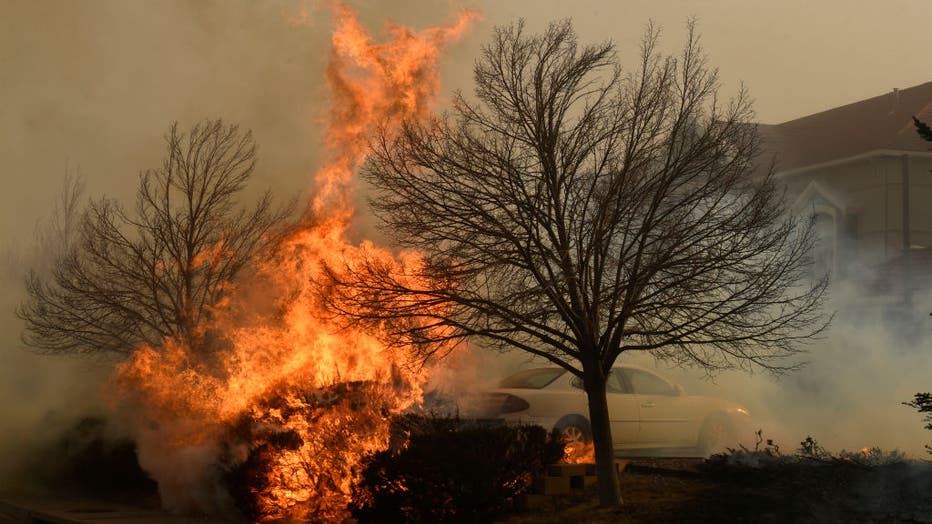Colorado wildfires: At least 580 homes destroyed, 34K evacuated
DENVER - Fire officials were assessing the damage on Friday after wildfires fueled by gusty winds tore through two Colorado cities and burned an estimated 580 homes, a hotel and a shopping center.
A total of 34,000 people were evacuated on Thursday in the cities of Louisville and Superior, located about 20 miles northwest of Denver, after fires broke out unusually late in the year. Officials said an extremely dry fall and a winter so far nearly devoid of snow led to the intensity of fires that quickly swept across the region.
At least one first responder and six others were injured. Boulder County Sheriff Joe Pelle acknowledged that more injuries and also deaths could be possible.
"This is the kind of fire we can’t fight head on," Pelle said. "We actually had deputy sheriffs and firefighters in areas that had to pull out because they just got overrun," he added.

FILE - Fire burns in bushes near a La Quinta hotel on Dec. 30, 2021, in Louisville, Colorado. (Photo by Helen H. Richardson/MediaNews Group/The Denver Post via Getty Images)
Pelle said the first fire erupted just before 10:30 a.m. and was "attacked pretty quickly and laid down later in the day and is currently being monitored" with no structures lost.
A second wildfire, reported just after 11 a.m., "ballooned and spread rapidly east," Pelle said. The blaze spanned at least 2.5 square miles.
Some of the several fires in the area Thursday were sparked by downed power lines.
As night fell, officials were watching how the winds behaved and the fires reacted to determine when crews are able to go in and begin assessing the damage and searching for any victims.
The neighboring towns are filled with middle and upper-middle class subdivisions surrounded by shopping centers, parks and schools. The area is in between Denver and Boulder, a foothills college town home to the University of Colorado.
Residents evacuated fairly calmly and orderly, but the winding streets in the subdivisions quickly became clogged as people tried to get out. It sometimes took cars as long as 45 minutes to advance about a half-mile.
Small fires cropped up here and there in surprising places — on the grass in a median or in a dumpster in the middle of a parking lot — as wind gusts up to 105 mph caused the fire to jump and spread. Shifting winds caused the skies to turn from clear to smoky and then back again as emergency sirens blared nearby.
"Residents who evacuated/have property in evacuation zones, please do NOT return to the area," the Boulder Office of Emergency Management wrote Friday morning on Twitter. "We know that you are concerned about your home/belongings. We will notify you about re-entering your homes as soon as we can!"
The fires also prompted Gov. Jared Polis to declare a state of emergency, allowing the state to access disaster emergency funds.
"Prayers for families evacuating from the fires in Superior and Boulder County," Polis wrote in a tweet on Thursday.
Colorado’s Front Range, where most of the state’s population lives, had an extremely dry and mild fall, and winter so far has continued to be mostly dry. Denver set a record for most consecutive days without snow before it got a small storm on Dec. 10. It hasn’t snowed since, though snow was expected in the region Friday.
Scientists say climate change is making weather more extreme and wildfires more frequent and destructive. A historic drought and heat waves have made wildfires harder to fight in the U.S. West.
Ninety percent of Boulder County is in severe or extreme drought and hasn’t seen substantial rainfall since mid-summer.
"With any snow on the ground, this absolutely would not have happened in the way that it did," said snow hydrologist Keith Musselman, who was at home when Thursday's fires broke out not far away.
This story was reported from Cincinnati. The Associated Press contributed.



